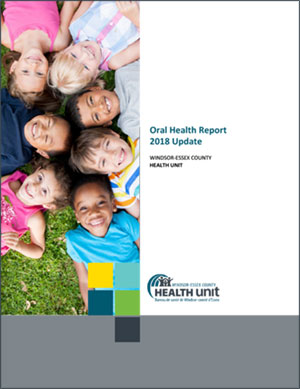Executive Summary
Oral health is vital to general health and overall well-being at every stage of life. Most oral health conditions are largely preventable and share common risk factors with other chronic disease, as well as their underlying social determinants of health, such as income, employment, education, or other social factors that can impact health.
Public health units are well-situated to take a leading role in improving oral health in the communities they serve. The Oral Health Report 2018 Update was prepared by the Windsor- Essex County Health Unit to provide current information about the oral health status of residents in the City of Windsor and the County of Essex. The key findings are summarized below.
Oral health profile of Windsor-Essex County:
- Nearly 1 in 4 residents report having no dental insurance coverage.
- Just over 1 in 10 households with a child between 1 and 6 years, saw a dental professional for their child for the first time before their child’s first birthday
- There is an average of 921 emergency department visits each year for problems related to oral health.
- The estimated average total cost for emergency dental visits is $508,259 per year in Windsor-Essex County.
- Over 9 in 10 visits to the emergency departments were by adults (18+) with the highest rates observed in young adults between 20 to 29 years of age.
- Each year, there is an average of 1,323 day surgeries for oral health (caries-related) reasons with the rates of day surgeries consistently higher in children (1 to 17 years) between 2010 and 2016.
- Approximately 4 in 5 residents in Windsor-Essex County support community water fluoridation.
- None of the nine municipalities in Windsor-Essex County fluoridate their water supplies.
Oral health assessment in schools and preventative services in Windsor-Essex County:
- In the 2016/2017 school year, 18,179 children from 119 schools were screened for oral health issues. Between 2011/2012 to 2016/2017, the percentage of children with decay or requiring urgent care has increased by 51%.
- A three-fold increase in the proportion of children eligible for topical fluoride was observed between the 2011/2012 and 2016/2017 school years.
- When compared to Ontario, the percentage of children with urgent dental needs in 2016/2017 was two-times greater in Windsor-Essex County. A similar trend was observed for all other school years.
- There is a decreasing trend in the proportion of caries-free children observed in JK, SK and Grade 2, from 7 in 10 (70%) children being caries-free in JK to 5 in 10 (50%) in Grade 2.
- The measure of decayed, missing, extracted, and filled teeth (deft/DMFT index) was highest in 2016/2017 and lowest in 2011/2012 school year indicating a trend in more oral health concerns among children at the time of school entry over time. Similar observations were found across the different grades.
- From 2011/2012 to 2016/2017, communities that recently ceased fluoridation observed a greater decrease in the percentage (13%) of students without caries compared to an 8% decrease in the communities that were never fluoridated.
- Between 2011/2012 and the 2016/2017 school year, there were no instances of moderate or severe fluorosis in children screened.
- With the new Healthy Smiles Ontario program, a total of 7,973 preventative oral health services were offered by the Windsor-Essex County Health Unit in the 2016/2017 school year.


